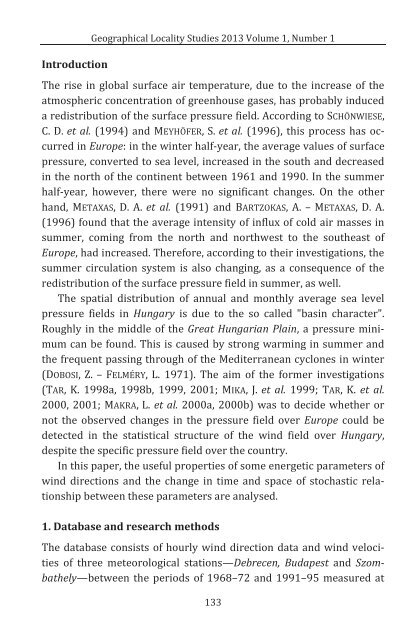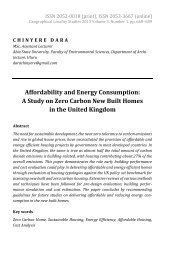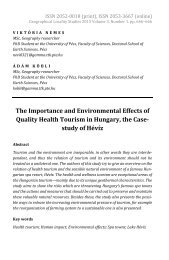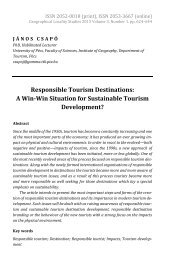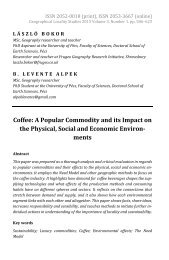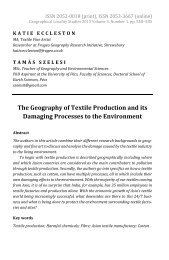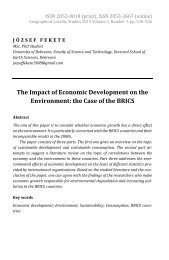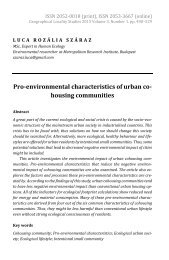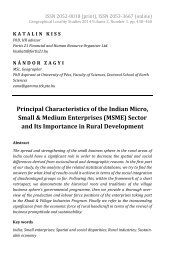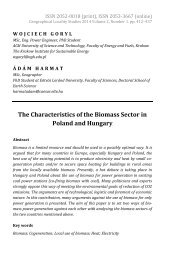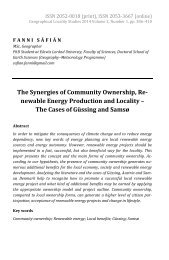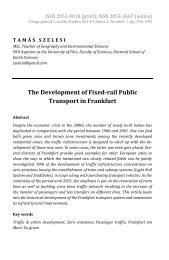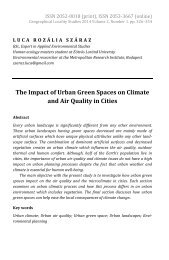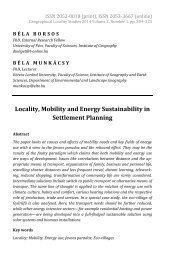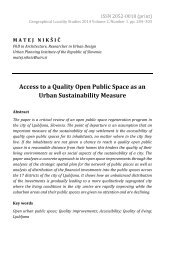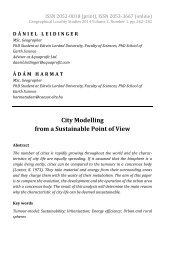Károly Tar: Energetic Parameters of the Wind Directions
The objective of this study is to assess whether changes in the surface pressure field over Europe are reflected in the statistical structure and the inner definiteness of the wind energy (relative frequency, relative energy content, mean velocity, etc.) field over Hungary, despite the country’s specific pressure field.
The objective of this study is to assess whether changes in the surface pressure field over Europe are reflected in the statistical structure and the inner definiteness of the wind energy (relative frequency, relative energy content, mean velocity, etc.) field over Hungary, despite the country’s specific pressure field.
You also want an ePaper? Increase the reach of your titles
YUMPU automatically turns print PDFs into web optimized ePapers that Google loves.
Introduction<br />
Geographical Locality Studies 2013 Volume 1, Number 1<br />
The rise in global surface air temperature, due to <strong>the</strong> increase <strong>of</strong> <strong>the</strong><br />
atmospheric concentration <strong>of</strong> greenhouse gases, has probably induced<br />
a redistribution <strong>of</strong> <strong>the</strong> surface pressure field. According to SCHÖNWIESE,<br />
C. D. et al. (1994) and MEYHÖFER, S. et al. (1996), this process has occurred<br />
in Europe: in <strong>the</strong> winter half-year, <strong>the</strong> average values <strong>of</strong> surface<br />
pressure, converted to sea level, increased in <strong>the</strong> south and decreased<br />
in <strong>the</strong> north <strong>of</strong> <strong>the</strong> continent between 1961 and 1990. In <strong>the</strong> summer<br />
half-year, however, <strong>the</strong>re were no significant changes. On <strong>the</strong> o<strong>the</strong>r<br />
hand, METAXAS, D. A. et al. (1991) and BARTZOKAS, A. – METAXAS, D. A.<br />
(1996) found that <strong>the</strong> average intensity <strong>of</strong> influx <strong>of</strong> cold air masses in<br />
summer, coming from <strong>the</strong> north and northwest to <strong>the</strong> sou<strong>the</strong>ast <strong>of</strong><br />
Europe, had increased. Therefore, according to <strong>the</strong>ir investigations, <strong>the</strong><br />
summer circulation system is also changing, as a consequence <strong>of</strong> <strong>the</strong><br />
redistribution <strong>of</strong> <strong>the</strong> surface pressure field in summer, as well.<br />
The spatial distribution <strong>of</strong> annual and monthly average sea level<br />
pressure fields in Hungary is due to <strong>the</strong> so called "basin character".<br />
Roughly in <strong>the</strong> middle <strong>of</strong> <strong>the</strong> Great Hungarian Plain, a pressure minimum<br />
can be found. This is caused by strong warming in summer and<br />
<strong>the</strong> frequent passing through <strong>of</strong> <strong>the</strong> Mediterranean cyclones in winter<br />
(DOBOSI, Z. – FELMÉRY, L. 1971). The aim <strong>of</strong> <strong>the</strong> former investigations<br />
(TAR, K. 1998a, 1998b, 1999, 2001; MIKA, J. et al. 1999; TAR, K. et al.<br />
2000, 2001; MAKRA, L. et al. 2000a, 2000b) was to decide whe<strong>the</strong>r or<br />
not <strong>the</strong> observed changes in <strong>the</strong> pressure field over Europe could be<br />
detected in <strong>the</strong> statistical structure <strong>of</strong> <strong>the</strong> wind field over Hungary,<br />
despite <strong>the</strong> specific pressure field over <strong>the</strong> country.<br />
In this paper, <strong>the</strong> useful properties <strong>of</strong> some energetic parameters <strong>of</strong><br />
wind directions and <strong>the</strong> change in time and space <strong>of</strong> stochastic relationship<br />
between <strong>the</strong>se parameters are analysed.<br />
1. Database and research methods<br />
The database consists <strong>of</strong> hourly wind direction data and wind velocities<br />
<strong>of</strong> three meteorological stations—Debrecen, Budapest and Szomba<strong>the</strong>ly—between<br />
<strong>the</strong> periods <strong>of</strong> 1968–72 and 1991–95 measured at<br />
133


